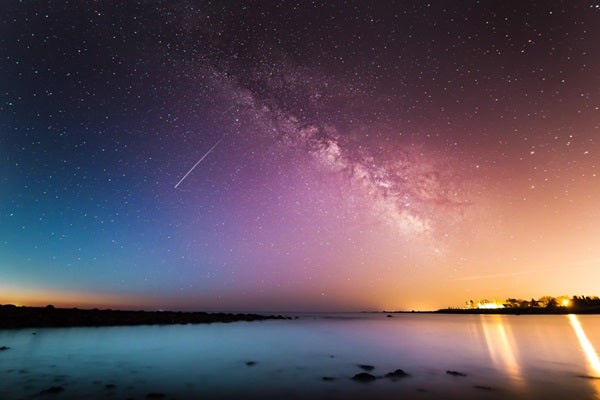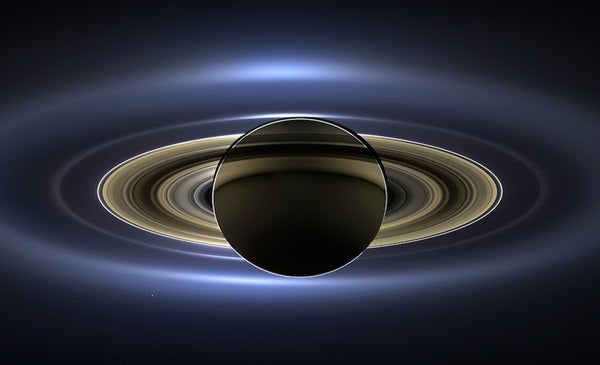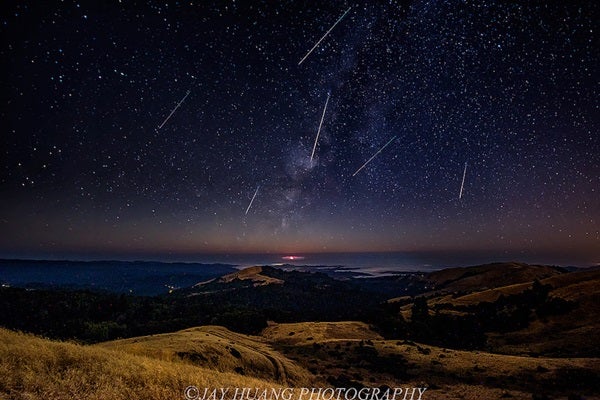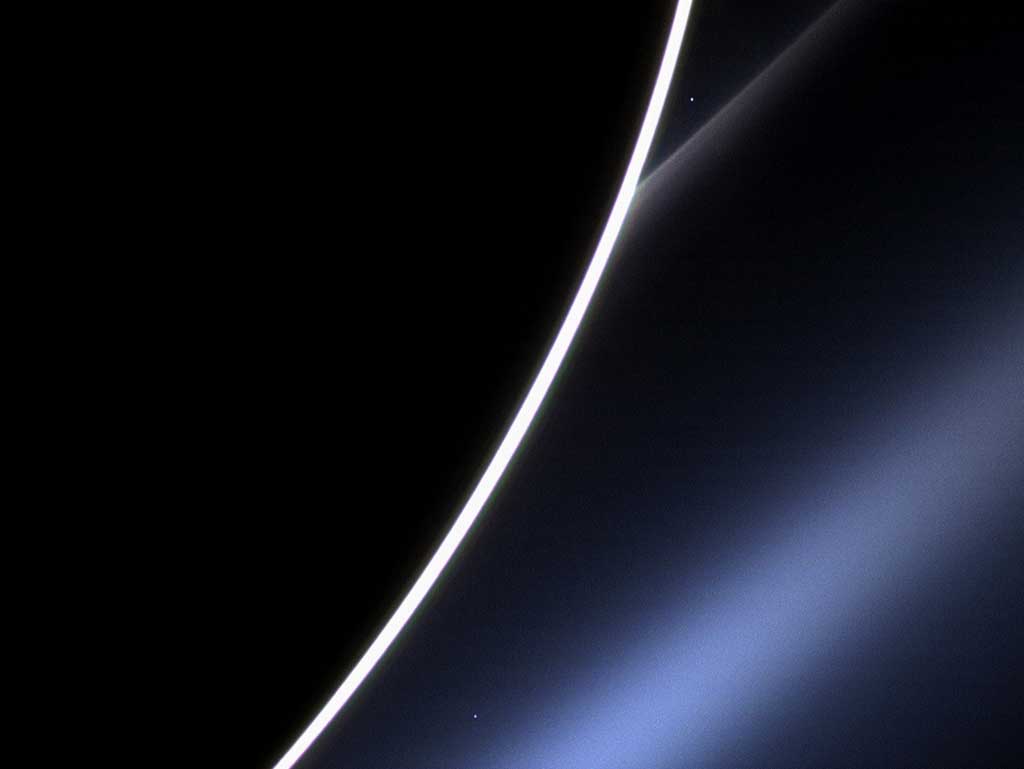Although Jupiter reached opposition and peak visibility nearly three months ago, it remains a stunning sight from evening twilight until it sets around midnight local daylight time. Jupiter shines at magnitude –2.1 and dominates the southwestern sky as night falls. The gas giant resides among the background stars of Libra the Scales, 1.3° northwest of Zubenelgenubi (Alpha [α] Librae). If you view the planet through a telescope tonight, its disk spans 38″ and displays spectacular cloud-top detail. You’ll also see the gas giant’s four brightest moons. These are the biggest of Jupiter’s entourage of 79 satellites; this number grew by a dozen last month when astronomers announced their discovery of several more far-flung moons.
Saturday, August 4
Last Quarter Moon occurs at 2:18 p.m. EDT. It doesn’t rise until 12.30 a.m. local daylight time tomorrow, however, by which time North American observers might notice that its phase has diminished to 44 percent lit. Earth’s only natural satellite spends the morning near the border between the constellations Aries the Ram and Taurus the Bull.
Sunday, August 5
Saturn reached its peak a little more than a month ago, when it appeared opposite the Sun in the sky, and our view of the ringed planet remains magnificent. It appears against the backdrop of northern Sagittarius, a region that climbs highest in the south between 10 and 11 p.m. local daylight time. Saturn continues to shine brightly, too, at magnitude 0.2. When viewed through binoculars, you’ll find the Trifid Nebula (M20) 2.5° west of the planet, with the even brighter Lagoon Nebula (M8) 1° south of the Trifid. But the best views of Saturn come through a telescope, which reveals the planet’s 18″-diameter disk surrounded by a dramatic ring system that spans 41″ and tilts 26° to our line of sight.
Look for the waning crescent Moon this morning as it hovers just west of the Hyades star cluster in Taurus the Bull. The two objects clear the horizon by 2 a.m. local daylight time and climb one-third of the way to the zenith in the eastern sky by the time morning twilight begins. The Moon appears about 30 percent lit and easily outshines the stars of the V-shaped Hyades. First-magnitude Aldebaran, which marks one tip of the V, appears brighter than the rest of the cluster’s stars because it actually lies in the foreground.
Tuesday, August 7
Distant Neptune reaches opposition and peak visibility in just a month, but the view now is essentially the same. The ice giant planet rises around 9:30 p.m. local daylight time and climbs halfway to the zenith in the south by 3 a.m. The magnitude 7.8 planet lies in Aquarius, 1.5° west-southwest of 4th-magnitude Phi (φ) Aquarii. You’ll need binoculars to spy Neptune and a telescope to see its blue-gray disk, which spans 2.3″.
Uranus’ eastward motion against the background stars comes to a halt at 5 p.m. EDT. This so-called stationary point marks the beginning of the best period to observe the outer planet. Uranus rises before midnight local daylight time and appears more than halfway to the zenith in the southeastern sky as morning twilight commences. The magnitude 5.8 planet lies in the southwestern corner of Aries, 12° south of 2nd-magnitude Hamal (Alpha [α] Arietis). A telescope reveals Uranus’ blue-green disk, which spans 3.6″.
Wednesday, August 8
The middle of this week finds observers caught between the peaks of two nice meteor showers. The Southern Delta Aquariid shower reached maximum July 30 and has started to diminish, while the Perseid shower is ramping up in preparation for its peak the night of August 12/13. The waning crescent Moon sheds little light in the predawn sky, and conditions improve as the week progresses and Luna’s phase wanes. You can tell meteors from the two showers apart by tracing their paths backward. Southern Delta Aquariid meteors appear to radiate from the constellation Aquarius the Water-bearer, while Perseid meteors emanate from Perseus the Hero.
Mercury reaches inferior conjunction, passing between the Sun and Earth, at 10 p.m. EDT. The innermost planet will return to view before dawn in about two weeks.
Mars remains near its glorious peak all this week. The Red Planet reached opposition the night of July 26/27 and made its closest approach to Earth (at a distance of 35.8 million miles [57.6 million kilometers]) on the 31st. Mars appears low in the southeast as darkness falls and grows more prominent as the evening wears on and it climbs higher. By midnight local daylight time, it stands about 25° high in the south against the backdrop of stars in southwestern Capricornus. The world shines at magnitude –2.6, making it the second-brightest point of light in the night sky after Venus. When viewed through a telescope, the planet’s ocher-colored disk spans 23.9″. The global dust storm appears to be waning, and patient observers should be able to spot some subtle surface details.
Friday, August 10
Venus dominates the western sky after sunset. The dazzling object shines at magnitude –4.4 among the background stars of western Virgo. The planet appears 11° high 45 minutes after sundown and sets just before 10 p.m. local daylight time. When viewed through a telescope, Venus appears 23″ across and a hair over half-lit.
The Moon reaches perigee, the closest point in its orbit around Earth, at 2:07 p.m. EDT. It then lies 222,500 miles (358,078 kilometers) away from us.
New Moon occurs at 5:58 a.m. EDT. At its New phase, the Moon crosses the sky with the Sun and so remains hidden in our star’s glare. At least, that’s what it will do for much of the world’s population. But if you happen to live in northern Canada, northern Europe, or parts of Asia, you can watch the Moon pass in front of the Sun and cause a partial solar eclipse. From Beijing, the Moon covers one-third of our star’s diameter just before sunset. Remember that when viewing the Sun during a partial eclipse, you need to protect your eyes with a safe solar filter.
Sunday, August 12
The annual Perseid meteor shower reaches its peak tonight under perfect conditions. The shower not only produces lots of “shooting stars” — up to 110 per hour under optimal circumstances — but it does so with the Moon out of the sky. The best views will come in the predawn hours of Monday morning when the shower’s radiant — the spot on the border between Perseus and Cassiopeia where the meteors appear to emanate — climbs highest. To see the most meteors, observe from a spot far removed from the lights of the city.













